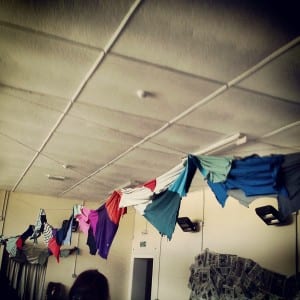The Women of War characters were a prominent part of the beginning of our performance, Safe Bet. We performed a repetitive sequence in front of the wall, next to the Weighing Room. The four hooks on the wall symbolised a mirror for each woman, and we continuously moved down the line of hooks, applying different make-up at each mirror. For example, I applied powder at the first hook and then moved to the next hook, passing the object to another woman, whilst also receiving the lipstick. The sequence continued while the audience were greeted by the sound of the megaphone.
The first performances took place in a rotation format, and the audience went to the different performances in small groups. During the rotation, the audience returned to the seating area in the Weighing Room, to await the next performance/activity. We, the Women of War, remained in the corner of the room, and applied make-up and styled our hair. We also dabbed tea onto our legs and drew black lines onto our calves, which was a popular act of women during the war, to create the illusion that they were wearing silk stockings. Thus, the scent of tea and sweet perfume drifted through the room, for the audience to feel absorbed in the piece, as their senses were heightened. The action of waiting was also a chance for the audience to reflect on what they had experienced so far. Wolfgang Iser states that “Social communication […] arises out of the fact that people cannot experience how others experience” ((Iser, Wolfgang (2001) ‘Interaction between Text and Reader’ in Colin Counsell and Laurie Wolf (ed.) Performance Analysis, London: Routledge.)). As a result, the ‘waiting in limbo’ space that was created was an opportunity for the audience to briefly share opinions.
After the application of make-up, we (as the women) stood proudly in front of the audience. We wanted the audience to see the women as merely being on display, as they were during the pre-war period. Thus, we highlighted our smart, feminine attire and pristine make-up by posing in a row. Our position was a direct contrast to the factory scene that occurred later, where the women had a true purpose and an important role in Britain’s success in the war. Our journey and the transformation of the women throughout the performance is represented through the large cloth that we hung above the length of the Weighing Room ceiling. The cloth also symbolised the aeroplane wings that the Women of War sewed in the factories, and the fact that we used unwanted clothing of our fellow group members also emphasised our strong theme of community.
The Women of War’s main piece of the performance was the factory sewing scene, in the kitchen/shower room. The scene can be regarded as an exhibition and a piece of ‘Museum Theatre’. Catherine Hughes states:
In this age of deconstruction, the new focus on education has rattled the foundations of museums by bringing up questions about how we view knowledge, how we perceive the learning process, and how we determine whose point of view is dominant ((Hughes, Catherine (1998) ‘The Nature of Museums and Theatre’, Museum Theatre, Portsmouth: Heinemann.)).
Thus, the audiences’ reactions made each of us realise how thought provoking our scene had been. For example, my role was to greet the audience and invite a maximum of five people into the kitchen space. Ironically, the audience members that I chose were all male, yet this happened at random. However, a member of the audience later stated that he found the close proximity of the male audience highly poignant, as it highlighted the contrast between the genders, and suggested that the women’s hard work was, in contrast, overlooked by the men during the war. I informed the audience member that this was unintentional, yet the selection of the five males had created a new perspective of our scene. Another unexpected audience reaction that occurred during the scene was when the audience had their tea swiftly taken off them and poured down the urinals. There were many sighs of disappointment and reluctance, which highlighted the happiness and comfort that people feel with a cup of tea. Furthermore, the reactions emphasised the important message of the scene, which consisted of the tea representing community, and how community is literally being ‘poured down the drain’. Also metaphorically, the removal of the tea signifies how the Grandstand site is currently wasted and discarded. Cathy Turner reflects on such an occurrence, believing that “each occupation, or traversal, or transgression of space offers a reinterpretation of it, even a rewriting” ((Turner, Cathy (2004) ‘Palimpsest or Potential Space? Finding a Vocabulary for Site-Specific Performance, New Theatre Quarterly, XX (4) pp. 373-390.)), and personally, the opportunity for a plethora of meanings and audience interpretations, is the essence of site-specific performance.
